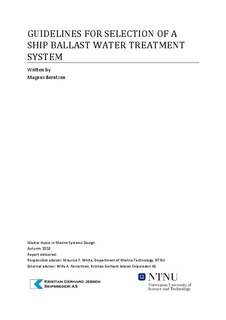Guidelines for selection of a ship ballast water treatment system.
Master thesis
Permanent lenke
http://hdl.handle.net/11250/237716Utgivelsesdato
2010Metadata
Vis full innførselSamlinger
- Institutt for marin teknikk [3431]
Sammendrag
The purpose of the thesis was to develop a decision support system for ballast water treatment systems, considering both technical and economical aspects of the system. This was done by developing a two part model, which considers both physical constraint given by the ship, and KPI analysis.
In order to test the model, it was applied on two vessels from KGJS fleet; MV Corrella Arrow, a 72.000 DWT general cargo ship, and a cement carrier that is currently being built in Vietnam. For both these ships the model identified 6 – 8 systems that were applicable, but by applying ship specific constraints and additional knowledge of the systems it was possible to eliminate several other systems. As a means to further eliminate systems, a detailed analysis was required.
When analysing the operational costs, it was found that installing a treatment system will increase the daily operational costs with $1 - $30, and increase the annual fuel consumption with 1 – 20 tons. This is negligible when compared to the installation and investment cost.
For the cement carrier it was that two systems were applicable to the ship; OptiMarin Ballast System and Hyde Guardian. Where Hyde Guardian be too large, OptiMarin Ballast system will have a higher cost. Simplicity have to be considered against cost.
For MV Corrella Arrow, WSE Unitor was found to be the best option. However, it should be noted that as the reactor unit is located before the ballast pumps, the negative effects it might have on the ballast pumps should be closely monitored after installation.
